
On this page, we will understand the internal energy formula, internal energy formula, ideal gas, specific internal energy formula, change in internal energy equation, and the total internal energy formula.Īs per the first law of thermodynamics, the energy of the universe is invariant.Īlso, the change in the internal energy of a system equals the total of the heat transferred and the work done.īesides this, the heat added/flown is equal to the sum of the change in the internal energy of the system and the PV work done. The change in internal energy equals the difference in the heat flow in a system and the work done by/on the system (PV) and the change in internal energy formula helps us calculate the same. We can calculate the same by the internal energy formula. In short, internal energy is the energy associated with the random motion or disordered arrangement of particles within the system, which is measured in KJ or Joule. It is the energy of a substance due to kinetic and potential energies that are associated with the random motion of all the particles that make up the substance. Internal energy is also called thermal energy. It is symbolized by the English letter ‘U.’

Where the hit occurred.The energy contained within the system is called internal energy. (energy) dissipates through air, when a book drops and hits the floor and theįloor gets warmer (molecules vibrate more rapidly) spreading out from the spot Heat (defined later) is random (disorganized) energy that is released orĪbsorbed, often as a result of some work being done, e.g., sound Work is organized energy, lifting a book, etc. Potential Energy both of these can be forms of work and of heat energy Work done when gases are evolved or used up in the reaction. In chemical situations, we are normally interested only in the atmospheric It has used up energy so we can now write down a more complete definition for Hence, did the work of pushing back the atmosphere (positive value for Δ V), (Described later) Since the system increased in volume and The only thing left to decide is the signĬonvention. Hence, we can calculate the magnitude of the work The force needed to pushīack the atmosphere is actually P atm × A where P atm and moves the piston a distance Δ x. In this case, one pushes back against the atmospheric pressure Work can also be done by pushing back the atmosphere (piston in aĬylinder). This is a mechanical work and serves as the basis for our definition of PV One of the most common definitions for work is when a force f displaces an object by a distance Δ xĭoes work w = f × Δ x. Work and will use the symbol w to refer only to that type of work.Īll other types of work will be referred to using a prime on the symbol, In chemistry, we generally are only interested in PV Light-energy work and work of expansion or contraction of a gas ( PV There is mechanical work, electrical work,

Energy The capacity to do work or to transfer heat Work Work is one means of transferring energy from our system to the Definitions: Thermodynamics The science of transformation of energy. Theseĭefinitions must be very tightly specified and understood in order to properlyįollow some of the more complex logic in later pages. Processes, we need to first develop a few terms that we will use. To begin the study of the transformation of energy in chemical (or other)



 0 kommentar(er)
0 kommentar(er)
